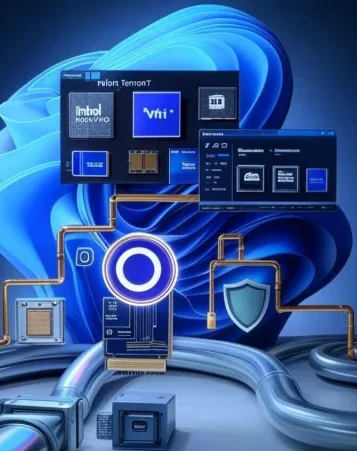Microsoft announced Windows ML as generally available for developers in 2025 — a native, production-ready on-device inference runtime included in the Windows App SDK that makes it dramatically easier to ship AI features that run locally on Windows 11 devices. In short: Windows wants AI to run on the PC itself, not just in the cloud.
That shift — from cloud-first AI to first-class on-device AI — matters for three concrete reasons: latency, cost, and privacy. Local inference removes round trips to cloud endpoints, so UI interactions that depend on models feel instantaneous. It also reduces recurring cloud compute bills for bandwidth-heavy or low-latency features. Critically, sensitive inputs (images, documents, microphone content) can be processed without leaving the machine, which changes the privacy model for many apps.
What Windows ML actually provides for developers
Windows ML builds on ONNX Runtime and the WinRT APIs to give developers a common runtime that automatically picks the best “execution provider” for a device — CPU, GPU, or a neural processing unit (NPU). The platform includes tooling to discover, download, and register vendor execution providers so apps don’t need bespoke packaging for each silicon vendor. That hardware abstraction is the technical linchpin: a single app binary can run optimized inference on a cheap laptop, a gaming GPU, or a Copilot+ PC with dedicated NPU.
Windows ML is distributed with the Windows App SDK (starting in specific versions) and exposes simple APIs to load ONNX models and run inference. Microsoft and partners say the runtime also handles dependency management for execution providers so developers spend less time on packaging and compatibility headaches. This lowers the practical barrier to shipping on-device features.
How UX and app architecture will change
Expect new UI patterns that assume immediate model responses: image editors that show semantic edits in real time, document apps that index and summarize local files instantly, and collaboration tools that run anonymized local analysis before optionally sending minimal metadata to the cloud. Designers will prioritize progressive enhancement: local model first, cloud only when higher accuracy or cross-user aggregation is required.
From an engineering standpoint, apps will adopt a hybrid inference model more often: small, fast models for local pre-processing and fall back to cloud models for heavy lifting. The runtime’s ability to manage EPs simplifies this hybrid approach because the same model can target different hardware backends without shipping separate installers.
Privacy: stronger by default, but not automatic
On-device inference significantly improves the privacy baseline: raw user data can remain on the device and never be transmitted. That’s a powerful win for features that process private content (photos, local documents, microphone streams). However, privacy gains are not automatic. Developers still choose whether a feature stays local or sends telemetry for improvement; model provenance and update mechanisms create new risk vectors. If an app downloads updated execution providers or models automatically, it must disclose that behavior and provide controls. IT administrators will want policies to govern model downloads and trust boundaries.
Another privacy consideration is provenance and licensing: many models are trained on proprietary or scraped data. Even when inference happens locally, companies must be clear about model licensing and whether output could inadvertently reproduce copyrighted content. In enterprise deployments, organizations may prefer on-prem model registries or vetted model catalogs rather than allowing arbitrary model downloads.
Performance, security, and supply chain realities
Running inference locally reduces latency, but it also adds CPU/GPU/NPU utilization to the device budget. For battery-sensitive devices, model choice and runtime scheduling matter; the Windows ML APIs are intended to help by selecting the most efficient hardware path. Security teams should treat models and EPs as first-class supply-chain artifacts: signed packages, integrity checks, and explicit admin controls will be necessary for regulated environments.
Hardware partners (GPU and NPU vendors) are already positioning execution providers optimized for their silicon. That collaboration is good for performance but means testing across devices will be essential. QA and telemetry frameworks should include model accuracy checks and fallbacks so users don’t see inconsistent behavior between devices.
Practical guidance for developers and IT
-
Start small with local models. Replace or augment latency-sensitive interactions with compact models and measure UX improvements.
-
Design hybrid fallbacks. Use local inference for immediacy and fall back to cloud models for higher-confidence results or cross-user features.
-
Control model provenance. Ship trusted models or integrate with a vetted model registry; avoid blind auto-downloads in enterprise builds.
-
Expose privacy controls. Let users opt into telemetry/model updates and document what stays local.
-
Test across hardware. Include representative devices in CI to capture differences driven by EPs and NPUs.
Final Words
Windows ML’s GA marks a practical turning point: Microsoft has put a production-grade on-device inference layer into the hands of mainstream Windows developers. That makes fast, private, and cost-efficient AI features easier to ship — but it also changes where responsibility sits: model governance, update policies, and testing become core product tasks. For app teams, the first rule remains the same as ever with new tools: ship thoughtfully, measure impact, and make privacy and provenance explicit.
